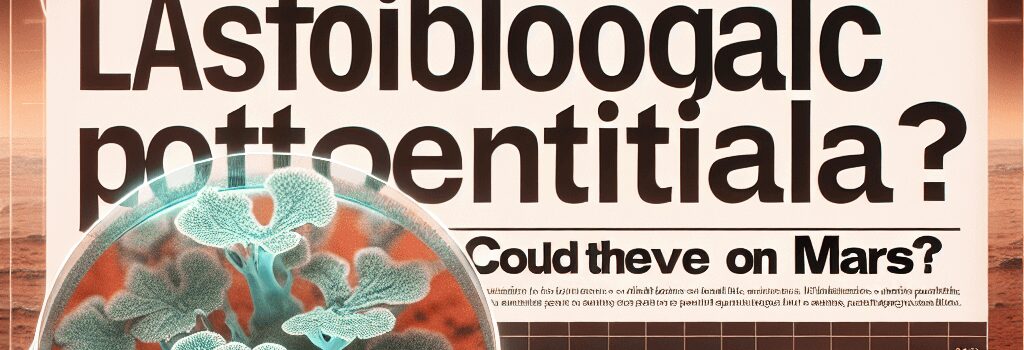Lichen’s Astrobiological Potential: Could They Thrive on Mars?

For decades, scientists have pondered the possibility of life enduring the harsh conditions beyond Earth. Although Mars is a world of extreme temperatures, high ionizing radiation, and a thin, carbon-dioxide-rich atmosphere, emerging research suggests that certain terrestrial organisms, such as lichens, may possess the unique resilience needed to survive on the Red Planet.
Experiments Under Simulated Martian Conditions
In a groundbreaking study led by botanist Kaja Skubała at the Space Research Center of the Polish Academy of Sciences, researchers investigated whether lichens might thrive in a Mars-like environment. The team focused on two species, Diploschistes muscorum and Cetrarea aculeata, exposing hydrated, metabolically active specimens to a controlled setting that mimicked key aspects of the Martian surface.
The experimental chamber replicated key Martian conditions: a low atmospheric pressure, minimal humidity, and temperatures fluctuating from a daytime 18° C (64° F) to a nighttime -26° C (-14° F). In addition, the researchers introduced X-ray levels designed to simulate the higher radiation associated with solar flares and solar energetic particle events, conditions that significantly compromise most Earthly life forms. By maintaining the lichens in a hydrated state, the study could evaluate the active metabolic functions of both the photosynthetic partner and the fungal component in conditions that are far removed from their natural habitat.
Understanding Lichen Symbiosis and Survival Mechanisms
Lichens are fascinating symbiotic organisms, composed of roughly 90% fungus and a 10% photosynthetic partner, which can be algae or cyanobacteria. This cooperative partnership endows lichens with a remarkable ability to withstand environmental extremes. Adaptations include the production of UV-absorbing metabolites and melanin pigments that shield cellular structures from radiation damage, as well as the capacity to enter a dormant state until conditions are favorable for reactivation.
The new study emphasized the fungal partner’s role—a perspective less examined than the response of the algae—to determine how it combats radiation damage while still actively metabolizing. Notably, the experiment demonstrated that D. muscorum retained lower levels of oxidative stress during exposure to ionizing radiation compared to C. aculeata, hinting at robust cellular repair mechanisms that could prove vital in a high-radiation environment like Mars.
Deeper Analysis: Radiobiology and Cellular Repair Mechanisms
Ionizing radiation is known to produce reactive oxygen species (ROS), which can damage proteins, cellular membranes, and DNA. However, D. muscorum exhibits a relatively high capacity to mitigate such oxidative damage. The study observed increased concentrations of antioxidants, particularly glutathione—a molecule imperative for neutralizing ROS. This adaptive response is similar to mechanisms found in other extremophiles such as tardigrades, which have long piqued the interest of biologists and astrobiologists alike.
Experts in radiobiology point out that an organism’s ability to repair cellular damage is key to surviving in environments with high radiation flux. Dr. Elena Khoury, a renowned astrobiologist, commented, “The cellular repair responses seen in these lichens might provide a blueprint not only for understanding life’s resilience but could also inspire bio-engineered solutions for radiation shielding in future space missions.”
Technical Specifications and Simulation Insights
To accurately mimic Martian conditions, the research team engineered a bespoke chamber with several controlled environmental parameters:
- Atmospheric Pressure: The low pressure within the chamber simulated Mars’ tenuous atmosphere, challenging the lichens’ ability to engage in oxygen-dependent metabolic processes.
- Temperature Variations: The controlled fluctuation from moderate daytime temperatures to frigid nighttime conditions tested the limits of the lichens’ thermal tolerance and metabolic flexibility.
- Ionizing Radiation: The X-ray exposure during the experiment was calibrated to mimic the peaks of Martian space weather, offering insights into the protective and repair mechanisms that might operate under such duress.
Additionally, fluorescence imaging of chlorophyll concentrations provided quantitative data. The photosynthetic partner in D. muscorum displayed robust resilience, with chlorophyll levels remaining largely unaltered during exposure, whereas C. aculeata showed a temporary decrease, later recovering its photosynthetic activity. This finding highlights the potential variance in survival dynamics among different lichen species.
Future Research Directions and Implications for Planetary Exploration
The implications of this study extend well beyond the laboratory. As space agencies plan for future manned and unmanned missions to Mars, understanding how terrestrial life forms respond to Martian conditions becomes increasingly significant. Further research is anticipated to involve long-term exposure experiments on the actual Martian surface, potentially integrated with onboard AI systems to monitor real-time biological responses.
This research not only informs theories of astrobiology but also guides the development of planetary protection protocols—crucial for preventing forward contamination. Robust models of extremophile survival could also catalyze innovations in bio-regenerative life support systems, leveraging these organisms’ natural properties to aid human space exploration.
Conclusion: Could Lichens Be Our Cosmic Pioneers?
The resilience of lichens in the face of extreme environmental stress adds a fascinating dimension to the ongoing search for life beyond Earth. The study led by Skubała and her team provides compelling evidence that certain lichens can maintain metabolic activity and repair radiation-related cellular damage, even under simulated Martian conditions. While much remains to be discovered, these findings not only contribute invaluable insights to the field of astrobiology but also raise important questions about the future of planetary exploration and the ethical considerations of introducing Earth-based life to other celestial bodies.
As the research community continues to explore the intersection of microbiology, radiobiology, and space science, lichens may well emerge as key models for how life could withstand the rigors of extraterrestrial environments. Future studies are expected to build on these results, paving the way for novel technologies and strategies that could one day support human and biological survival on Mars.
Source: Ars Technica